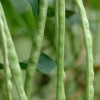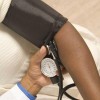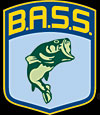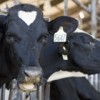 Folate is one of the B vitamins. It is involved in the formation of DNA, the genetic material found in all cells of your body. Folate is an important nutrient for everyone. It is especially important for pregnant and nursing women, growing children, and older adults. Health problems may result if people do not get enough folate. This 2-page fact sheet was written by Linda B. Bobroff, and published by the UF Department of Family Youth and Community Sciences, October 2012.
Folate is one of the B vitamins. It is involved in the formation of DNA, the genetic material found in all cells of your body. Folate is an important nutrient for everyone. It is especially important for pregnant and nursing women, growing children, and older adults. Health problems may result if people do not get enough folate. This 2-page fact sheet was written by Linda B. Bobroff, and published by the UF Department of Family Youth and Community Sciences, October 2012.
http://edis.ifas.ufl.edu/fy066
Author: dihagan
What Middle Schoolers Want to Talk About (FAR0804/FM246)
 “Can your middle-schooler talk to you? Most 10- to 14-year-olds want a warm, close relationship with their parents. However, only about a quarter of adolescents nationwide find their parents ‘approachable and available to talk.'” This 2-page Family Album Radio transcript was written by Suzanna Smith, and published by the UF Department of Family Youth and Community Sciences, September 2012.
“Can your middle-schooler talk to you? Most 10- to 14-year-olds want a warm, close relationship with their parents. However, only about a quarter of adolescents nationwide find their parents ‘approachable and available to talk.'” This 2-page Family Album Radio transcript was written by Suzanna Smith, and published by the UF Department of Family Youth and Community Sciences, September 2012.
http://edis.ifas.ufl.edu/fm246
Healthy Meal Plans (FCS8750/FY522)
 A meal plan is a guide to help you plan daily meals and snacks. It allows you to eat foods you enjoy and that provide a good balance of nutrients for your health. Meal plans can be used by anyone interested in healthy eating. They are very helpful for people who want to manage their weight.This 20-page fact sheet was written by Linda B. Bobroff, and published by the UF Department of Family Youth and Community Sciences, October 2012.
A meal plan is a guide to help you plan daily meals and snacks. It allows you to eat foods you enjoy and that provide a good balance of nutrients for your health. Meal plans can be used by anyone interested in healthy eating. They are very helpful for people who want to manage their weight.This 20-page fact sheet was written by Linda B. Bobroff, and published by the UF Department of Family Youth and Community Sciences, October 2012.
http://edis.ifas.ufl.edu/fy522
De compras para la salud: Guia de comidas congeladas (FSHN1202s/FS199)
 Sin embargo, con la gran variedad de comidas congeladas que están ahora en las tiendas de alimentos, es posible expandir sus opciones de alimentos y seguir consumiendo comidas apetitosas y saludables. La clave está en saber qué buscar cuando está comprando. Para aprender como escoger comidas deliciosas que satisfagan sus preferencias en cuanto al sabor y las necesidades de salud, continúe leyendo. This 4-page fact sheet was written by Sarah A. Glenny and Wendy J. Dahl, and published by the UF Department of Food Science and Human Nutrition, October 2012.
Sin embargo, con la gran variedad de comidas congeladas que están ahora en las tiendas de alimentos, es posible expandir sus opciones de alimentos y seguir consumiendo comidas apetitosas y saludables. La clave está en saber qué buscar cuando está comprando. Para aprender como escoger comidas deliciosas que satisfagan sus preferencias en cuanto al sabor y las necesidades de salud, continúe leyendo. This 4-page fact sheet was written by Sarah A. Glenny and Wendy J. Dahl, and published by the UF Department of Food Science and Human Nutrition, October 2012.
http://edis.ifas.ufl.edu/fs199
Talking to Children about Disasters (FAR8038/FM248)
 “Natural disasters, refugees displaced from their homes, loss of life . . . even for adults, these tragic events are difficult to understand. Children, too, may find these incidents especially troubling. Adults can help young people make sense of disasters and deal with their feelings by following a few guidelines.” This 2-page Family Album Radio transcript was written by Suzanna Smith, and published by the UF Department of Family Youth and Community Sciences, September 2012.
“Natural disasters, refugees displaced from their homes, loss of life . . . even for adults, these tragic events are difficult to understand. Children, too, may find these incidents especially troubling. Adults can help young people make sense of disasters and deal with their feelings by following a few guidelines.” This 2-page Family Album Radio transcript was written by Suzanna Smith, and published by the UF Department of Family Youth and Community Sciences, September 2012.
http://edis.ifas.ufl.edu/fm248
Preventing Childhood Obesity through Physical Activity (FAR8038/FM252)
 “Many parents are concerned about rising rates of childhood obesity. It’s important to keep a healthy perspective on the situation and not overreact with overly restrictive approaches that can do more harm than good. One way to promote healthy weights in children is to help them to be physically active.” This 2-page Family Album Radio transcript was written by Linda Bobroff, and published by the UF Department of Family Youth and Community Sciences, September 2012.
“Many parents are concerned about rising rates of childhood obesity. It’s important to keep a healthy perspective on the situation and not overreact with overly restrictive approaches that can do more harm than good. One way to promote healthy weights in children is to help them to be physically active.” This 2-page Family Album Radio transcript was written by Linda Bobroff, and published by the UF Department of Family Youth and Community Sciences, September 2012.
http://edis.ifas.ufl.edu/fm252
Bone Health (FAR8039/FM254)
 “When planning your family meals, you probably try to make sure your children get enough calcium and vitamin D, perhaps including a fresh cup of milk. Since milk is full of calcium, vitamin D, and other important nutrients, it’s one of the best foods for building strong bones. People who don’t get enough calcium or vitamin D are at risk for osteoporosis: weak bones that are more likely to fracture.” This 2-page Family Album Radio transcript was written by Jacob Young and Jennifer Hillan, and published by the UF Department of Family Youth and Community Sciences, September 2012.
“When planning your family meals, you probably try to make sure your children get enough calcium and vitamin D, perhaps including a fresh cup of milk. Since milk is full of calcium, vitamin D, and other important nutrients, it’s one of the best foods for building strong bones. People who don’t get enough calcium or vitamin D are at risk for osteoporosis: weak bones that are more likely to fracture.” This 2-page Family Album Radio transcript was written by Jacob Young and Jennifer Hillan, and published by the UF Department of Family Youth and Community Sciences, September 2012.
http://edis.ifas.ufl.edu/fm254
Improving Health and Happiness in the Home by Being an Energy Giver Rather Than an Energy Taker (FCS3313/FY1339)
 One way to improve health and happiness in the home is to work toward becoming an energy giver rather than an energy taker. The first step in doing this is to accept that you have some control regarding the attitude you choose to display during your waking hours. This 3-page fact sheet was written by Randall A. Cantrell and Victor W. Harris, and published by the UF Department of Family Youth and Community Sciences, October 2012.
One way to improve health and happiness in the home is to work toward becoming an energy giver rather than an energy taker. The first step in doing this is to accept that you have some control regarding the attitude you choose to display during your waking hours. This 3-page fact sheet was written by Randall A. Cantrell and Victor W. Harris, and published by the UF Department of Family Youth and Community Sciences, October 2012.
http://edis.ifas.ufl.edu/fy1339
Tobacco Budworm, Heliothis virescens (Fabricius) (Insecta: Lepidoptera: Noctuidae) (EENY219/IN376)
 The tobacco budworm, Heliothis virescens (Fabricius), is a native species and is found throughout the eastern and southwestern United States. It is principally a field crop pest, attacking such crops as alfalfa, clover, cotton, flax, soybean, and tobacco. Larvae bore into buds and blossoms (the basis for the common name of this insect), and sometimes the tender terminal foliar growth, leaf petioles, and stalks. This 6-page fact sheet was written by J. L. Capinera, and published by the UF Department of Entomology and Nematology, October 2012.
The tobacco budworm, Heliothis virescens (Fabricius), is a native species and is found throughout the eastern and southwestern United States. It is principally a field crop pest, attacking such crops as alfalfa, clover, cotton, flax, soybean, and tobacco. Larvae bore into buds and blossoms (the basis for the common name of this insect), and sometimes the tender terminal foliar growth, leaf petioles, and stalks. This 6-page fact sheet was written by J. L. Capinera, and published by the UF Department of Entomology and Nematology, October 2012.
http://edis.ifas.ufl.edu/in376
Alligatorweed flea beetle Agasicles hygrophila Selman and Vogt (Coleoptera: Chrysomelidae: Halticinae) (EENY462/IN831)
 Alligatorweed is an aquatic weed native to South America that began threatening Florida’s waterways in the early 1900s. Alligatorweed flea beetles kill the plant by destroying its stored food and interfering with photosynthesis by removing leaf tissue. This insect has been an extremely effective biological control agent in coastal regions of the southeastern United States. This 3-page fact sheet was written by Ted D. Center, James P. Cuda, Michael J. Grodowitz, and published by the UF Department of Entomology and Nematology, October 2012.
Alligatorweed is an aquatic weed native to South America that began threatening Florida’s waterways in the early 1900s. Alligatorweed flea beetles kill the plant by destroying its stored food and interfering with photosynthesis by removing leaf tissue. This insect has been an extremely effective biological control agent in coastal regions of the southeastern United States. This 3-page fact sheet was written by Ted D. Center, James P. Cuda, Michael J. Grodowitz, and published by the UF Department of Entomology and Nematology, October 2012.
http://edis.ifas.ufl.edu/in831
Aquatic Toxicology Notes: Endothall (SL369/SS570)
 Endothall is the herbicidal active ingredient found in commercial formulations labeled for weed control in aquatic systems and on ditch banks. It is also used as a defoliant and desiccant in some terrestrial situations (e.g., in potato, hops, cotton, clover, and alfalfa production). This 7-page fact sheet introduces users of endothall to the physical, chemical, environmental, and ecological properties of this herbicidal active ingredient relative to the aquatic environment. Written by P. Chris Wilson and Jun Wu, and published by the UF Department of Soil and Water Science, October 2012.
Endothall is the herbicidal active ingredient found in commercial formulations labeled for weed control in aquatic systems and on ditch banks. It is also used as a defoliant and desiccant in some terrestrial situations (e.g., in potato, hops, cotton, clover, and alfalfa production). This 7-page fact sheet introduces users of endothall to the physical, chemical, environmental, and ecological properties of this herbicidal active ingredient relative to the aquatic environment. Written by P. Chris Wilson and Jun Wu, and published by the UF Department of Soil and Water Science, October 2012.
http://edis.ifas.ufl.edu/ss570
Aquatic Toxicology Notes: Diquat (SL368/SS569)
 Diquat is applied directly to plants along ditch banks and within aquatic systems. It may also be applied to ponds, lakes, and drainage ditches to control algae and submersed aquatic weeds. This 7-page fact sheet introduces users of diquat to the physical, chemical, environmental, and ecological properties of this herbicidal active ingredient relative to the aquatic environment. Written by P. Chris Wilson and Jun Wu, and published by the UF Department of Soil and Water Science, October 2012.
Diquat is applied directly to plants along ditch banks and within aquatic systems. It may also be applied to ponds, lakes, and drainage ditches to control algae and submersed aquatic weeds. This 7-page fact sheet introduces users of diquat to the physical, chemical, environmental, and ecological properties of this herbicidal active ingredient relative to the aquatic environment. Written by P. Chris Wilson and Jun Wu, and published by the UF Department of Soil and Water Science, October 2012.
http://edis.ifas.ufl.edu/ss569
Healthy Eating: Fluids (FCS8569/FY070)
 More than one-half of an adult human body weight is water. Water brings nutrients to the cells in our bodies and removes waste. Our bodies cannot function without an adequate water supply. This 2-page fact sheet was written by Linda B. Bobroff, Luisa Oliver-Cordero, and Emily Minton, and published by the UF Department of Family Youth and Community Sciences, 10. http://edis.ifas.ufl.edu/fy070
More than one-half of an adult human body weight is water. Water brings nutrients to the cells in our bodies and removes waste. Our bodies cannot function without an adequate water supply. This 2-page fact sheet was written by Linda B. Bobroff, Luisa Oliver-Cordero, and Emily Minton, and published by the UF Department of Family Youth and Community Sciences, 10. http://edis.ifas.ufl.edu/fy070
Alimentacion Saludable: Liquidos (FCS8569Span/FY071)
 Más de la mitad del peso del cuerpo humano adulto, es agua. El agua transporta nutrientes a las células en nuestros cuerpos y remueve los residuos. Nuestros cuerpos no podrían funcionar sin una fuente de agua adecuada. This 2-page fact sheet was written by Linda B. Bobroff, Luisa Oliver-Cordero, y Emily Minton, and published by the UF Department of Family Youth and Community Sciences, October 2012.
Más de la mitad del peso del cuerpo humano adulto, es agua. El agua transporta nutrientes a las células en nuestros cuerpos y remueve los residuos. Nuestros cuerpos no podrían funcionar sin una fuente de agua adecuada. This 2-page fact sheet was written by Linda B. Bobroff, Luisa Oliver-Cordero, y Emily Minton, and published by the UF Department of Family Youth and Community Sciences, October 2012.
http://edis.ifas.ufl.edu/fy071
Florida Crop/Pest Management Profiles: Snap Beans (CIR1231/PI032)
 In 2009-2010, Florida growers produced 193.2 million pounds of snap beans, with a value of $0.69 per pound and a total value of $135 million. Snap beans were planted on 36,400 acres, and 32,200 acres were harvested, yielding an average of 6,000 pounds per acre. This 18-page fact sheet was written by W.M. Elwakil and Mark A. Mossler, and published by the UF Department of Agronomy, October 2012.
In 2009-2010, Florida growers produced 193.2 million pounds of snap beans, with a value of $0.69 per pound and a total value of $135 million. Snap beans were planted on 36,400 acres, and 32,200 acres were harvested, yielding an average of 6,000 pounds per acre. This 18-page fact sheet was written by W.M. Elwakil and Mark A. Mossler, and published by the UF Department of Agronomy, October 2012.
http://edis.ifas.ufl.edu/pi032
High Blood Pressure: What You Need to Know (FCS8638/FY199)
 High blood pressure, also called hypertension, increases your health risks. If you have high blood pressure, you have a higher chance of getting heart disease or kidney disease or of having a stroke. This 4-page fact sheet was written by Linda B. Bobroff, and published by the UF Department of Family Youth and Community Sciences, October 2012.
High blood pressure, also called hypertension, increases your health risks. If you have high blood pressure, you have a higher chance of getting heart disease or kidney disease or of having a stroke. This 4-page fact sheet was written by Linda B. Bobroff, and published by the UF Department of Family Youth and Community Sciences, October 2012.
http://edis.ifas.ufl.edu/fy199
The Economic Impact of the 2011 Florida BASS Federation Tournament to Osceola County and the Event's Economic Value to Participants (FE916)
 The Florida BASS Federation Nation is a chapter of a national organization whose goal is to stimulate public awareness of bass fishing as a major participant sport. Each the state Championship tournament attracts anglers to a competitive event in which participants seek to catch the largest cumulative weight of bass over two days. This article describes an assessment of the economic impact in Osceola County associated with the State Championship tournament. Findings from this analysis should help planners and other stakeholders of similar tournaments better estimate the economic benefits associated with such community activities. This 9-page fact sheet was written by Sherry Larkin, Jessica Georges, Alan Hodges, Michael Allen, and Dale Jones, and published by the UF Department of Food and Resource Economics, October 2012.
The Florida BASS Federation Nation is a chapter of a national organization whose goal is to stimulate public awareness of bass fishing as a major participant sport. Each the state Championship tournament attracts anglers to a competitive event in which participants seek to catch the largest cumulative weight of bass over two days. This article describes an assessment of the economic impact in Osceola County associated with the State Championship tournament. Findings from this analysis should help planners and other stakeholders of similar tournaments better estimate the economic benefits associated with such community activities. This 9-page fact sheet was written by Sherry Larkin, Jessica Georges, Alan Hodges, Michael Allen, and Dale Jones, and published by the UF Department of Food and Resource Economics, October 2012.
http://edis.ifas.ufl.edu/fe916
Comparing the Urine Ketone Strip Test and Handheld Ketone Meter to Diagnose Ketosis in Early Lactation Dairy Cows (VM186)
 Ketosis is a common metabolic disease in fresh dairy cows. Clinical and subclinical ketosis (SCK) can cause reduced milk yield, decreased milk protein, reduced reproductive capacity, and increased risk of displaced abomasum. Usually, diagnosing ketosis is performed by measuring acetoacetate or BHBA levels in the blood, urine, or milk samples. Measuring BHBA in serum or plasma is considered the gold standard diagnostic test for subclinical ketosis, because this method has stability, but the price for ketone strips is approximately $0.08/strip while the price for the the electronic BHBA measuring system is approximately $1.00. UF/IFAS researchers conducted a study to compare the two, using 72 Holstein cows between 14–40 days in milk from three dairy farms in north-central Florida with 450–800 lactating dairy cows. The key finding for this experiment is that no difference exists in BHBA concentration between cows that had a trace or small in the ketone strip reading. This 3-page fact sheet was written by Klibs N. Galvão, Achilles Vieira Neto, Gustavo Peña, Joao Bittar, and Lucas Ibarbia, and published by the UF Department of Veterinary Medicine-Large Animal Clinical Sciences, October 2012.
Ketosis is a common metabolic disease in fresh dairy cows. Clinical and subclinical ketosis (SCK) can cause reduced milk yield, decreased milk protein, reduced reproductive capacity, and increased risk of displaced abomasum. Usually, diagnosing ketosis is performed by measuring acetoacetate or BHBA levels in the blood, urine, or milk samples. Measuring BHBA in serum or plasma is considered the gold standard diagnostic test for subclinical ketosis, because this method has stability, but the price for ketone strips is approximately $0.08/strip while the price for the the electronic BHBA measuring system is approximately $1.00. UF/IFAS researchers conducted a study to compare the two, using 72 Holstein cows between 14–40 days in milk from three dairy farms in north-central Florida with 450–800 lactating dairy cows. The key finding for this experiment is that no difference exists in BHBA concentration between cows that had a trace or small in the ketone strip reading. This 3-page fact sheet was written by Klibs N. Galvão, Achilles Vieira Neto, Gustavo Peña, Joao Bittar, and Lucas Ibarbia, and published by the UF Department of Veterinary Medicine-Large Animal Clinical Sciences, October 2012.
http://edis.ifas.ufl.edu/vm186
Sleep Needs for Children (FAR0604/FM181)
 “Does your school-aged child complain about being sleepy during the day, doze off in class, or yawn a lot? Does he or she go to bed late or have trouble falling asleep? If so, your child may not be getting enough sleep.” This 2-page Family Album Radio transcript was written by Suzanna Smith, and published by the UF Department of Family Youth and Community Sciences, October 2012.
“Does your school-aged child complain about being sleepy during the day, doze off in class, or yawn a lot? Does he or she go to bed late or have trouble falling asleep? If so, your child may not be getting enough sleep.” This 2-page Family Album Radio transcript was written by Suzanna Smith, and published by the UF Department of Family Youth and Community Sciences, October 2012.
http://edis.ifas.ufl.edu/fm181
4-H School Enrichment: A Guide for 4-H Faculty and Staff (4H324)
 A partnership with the schools extends the 4‑H program to more youth through a unique delivery mode. Since School Enrichment may be a new experience for some Extension agents, this 8-page guide presents some strategies for developing a partnership with the schools and for programming. Written by Tracy A. Tesdall and published by the 4-H Youth Development Program, September 2012.
A partnership with the schools extends the 4‑H program to more youth through a unique delivery mode. Since School Enrichment may be a new experience for some Extension agents, this 8-page guide presents some strategies for developing a partnership with the schools and for programming. Written by Tracy A. Tesdall and published by the 4-H Youth Development Program, September 2012.
http://edis.ifas.ufl.edu/4h324